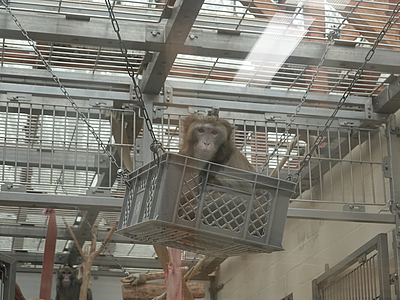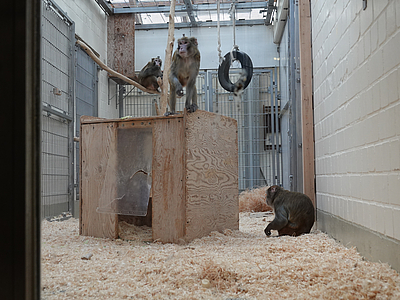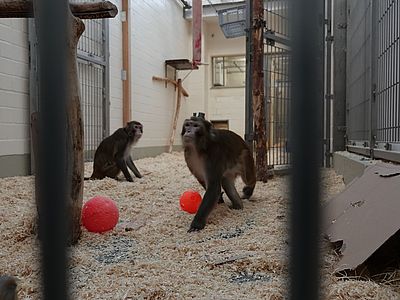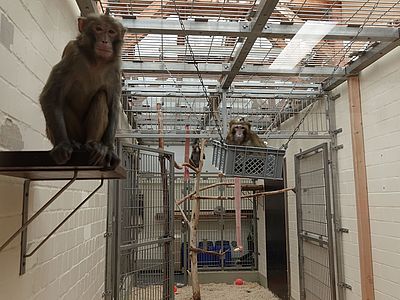Cognitive Neurophysiology Research Group
Questions on Brain Research at the University of Bremen
Basic research with rhesus monkeys (Macaca mulatta) in the field of brain research is carried out at the University of Bremen. Our researchers hope to gain a better understanding of the physiological basis of attention, memory, perceptual decision-making, and perception. Knowledge of the physiology of processing in the healthy brain is a prerequisite for being able to better treat the many forms of diseases and impairments of the brain in the future. The brain consists of about 100 billion nerve cells that are interconnected in a very complex way. Currently, little is known about how these cells interconnect moment to moment to form different functional groups to perform the diverse cognitive services that underlie our actions.
In recent years, Professor Andreas Kreiter and his team have been able to make important contributions to answering many related questions and have continuously published their research results in international scientific journals. This includes important results on the flexible exchange of information between nerve cells in large nerve cell assemblies (e.g. doi.org/10.3389/fncir.2018.00071 and doi.org/10.1523/JNEUROSCI.0689-20.2020) as well as work on making new measurement techniques applicable in medical contexts (e.g. rdcu.be/cl4g6).
The aim of the studies carried out at the institute is to ensure that the basic knowledge acquired can also be directly incorporated into applied research wherever this can already be achieved today.
As a general rule, the German Animal Welfare Act stipulates that animal experiments may only be carried out if no alternative methods can be used. The competent authority only approves an application for animal testing if researchers can prove that the research project cannot be carried out without animal testing and that the expected benefit of the experiment ethically justifies the possible suffering of the animal. Primates enjoy special protection under the law. Special, stringent conditions apply to them and research may only be carried out on them if this is not possible with non-primates. Our scientists proceed very responsibly and are subject to demanding legal requirements, which they carefully fulfill.
There are no alternative research methods to animal experiments for the studies conducted with rhesus monkeys at the University of Bremen:
A common claim is that one can recreate the physiology of the brain in a computer in order to subsequently conduct research using simulations. However, you can only recreate what you have previously researched and already know. To recreate the physiological processes of the brain would require a complete knowledge of the processes outlined above. This is currently just as impossible as, for example, exploring the universe by trying to recreate it in a computer. The sheer quantity of processes in the universe that have never been observed and the multitude of processes that are not yet understood make this impossible. The same is true for the study of the brain, which is a similarly complex and unexplored system.
However, one scientific approach is to first experimentally investigate individual, narrowly defined processes, to record these mathematically, and then to simulate them in a computer model, which is then used to model further, as yet unexplored processes. However, the results obtained in this way are only ever valid within the framework of the observations and assumptions that have been incorporated into the model and must in turn be tested experimentally for validity in the real brain. Such strategies are pursued in neuroscience and also at the institute of Prof. Kreiter and his colleagues (e.g. Ernst et al. 2021, PLOS Computational Biology (https://doi.org/10.1371/journal.pcbi.1009595)).
Another example used is the performance of so-called deep learning networks, a branch of AI research. Such networks can perform impressively in the area of pattern recognition. While these networks are inspired by findings from neuroscience, they do not replicate the brain. This is evident, for example, in the fact that computational pattern recognition is very computationally-demanding and time consuming, taking hours to produce results that the human brain computes in the blink of an eye.
There are no technical substitutes for the issues studied at the institute, nor is it possible to study them in other vertebrates.
The brains of vertebrates all have a fundamentally similar structure and have the same types of cells as humans. The human brain is neither unique in its structure nor in its basic mode of operation. However, humans are capable of cognitive feats that are not found in this form in all vertebrates. Primates, on the other hand, are primarily visual creatures, just like humans, whose visual perception and action planning are based on at least similar, often identical, principles as in humans. Therefore, cognitive processes can be studied in the monkey brain that provide information about similar processes in the human brain. The transferability of the findings has been proven many times: Mirror neurons were first discovered in monkeys before they could also be detected in humans, building on this knowledge. The cell physiological basis of Parkinson's disease was first described in monkeys, as were the temporal patterns associated with certain perceptual processes, which can be altered in brain diseases. The often populist accusation of non-transferability to humans shows a high degree of ignorance about the structure and function of brains. It also implies the problematic, anthropocentric idea of the uniqueness of the human brain in structure and function, for which there is no scientific evidence.
With reference to the lack of connection to the treatment or therapy of concrete neurological diseases, it is often claimed in public that the research conducted at the Brain Research Institute is useless. This ignores the fact that the essence of basic research is and must be to address questions about the functioning of an organ or a physiological process outside of concrete application-related questions. For example, several decades of basic research were required to understand the complex physiology of excitation propagation in the human heart, which today makes it possible to treat a wide range of heart diseases and has saved the lives of a large number of people. Application-related questions can usually only be addressed at all when basic knowledge has advanced to the point where it allows a concrete application-related approach. The human body is extremely complex and current and future medicine directly depends on understanding the processes underlying disease in detail. Providing this knowledge is the task of basic research.
According to the applicable laws, research on primates may only be carried out if there is no alternative for the investigation of a specific question - neither in the form of an animal-free approach nor in the form of an approach that could be carried out, for example, with mice or other non-primates. All experimental projects planned at the institute are not only reviewed by the licensing authority responsible for animal experiments, but also, in particular, by independent scientists in the course of the allocation of research funds and when manuscripts are submitted for publication. The work of the Bremen Brain Research Institute has led to a large number of publications in high-ranking international journals and is often cited in other international research papers. An overview of some of the issues being addressed at the institute is provided in a recent review (Kreiter AK, Current Opinion in Physiology, 2020, doi.org/10.1016/j.cophys.2020.08.008).
All experimental methods that are carried out and used as part of the behavioral training and testing are painless and are based strictly on the principle of positive reinforcement. The animals are initially trained in a series of small steps to climb out of their enclosure and into a so-called primate chair via an accessible cage. The primate chair is a mobile base made of transparent Plexiglas in which the animals can sit upright and in which their bodies have sufficient space to move. The animals put their heads through an opening at the top of the chair. They learn this by slowly getting to know the chair over several weeks of training and are rewarded with fruit or treats for the behavior they learn. Chair training is complete when the animals sit upright in the chair of their own accord and accept the reduction of the upper opening without showing signs of stress or other noticeable behavior.
The animals are then shown the premises and the laboratories – again in several small steps – and given sufficient time to look around and familiarize themselves with the facilities. The same procedure is followed in the laboratory, where the subsequent tests are carried out.
To carry out these tests, it is necessary for the animal's head to be still. For this reason, it is restrained during the tests with the aid of a head holder, which is implanted once under anesthesia at the beginning of the testing. The animals are also accustomed to this procedure slowly and carefully. For the training to be successful, it is essential that the animal trusts the trainer completely and that the training is painless and stress-free. The institute's employees entrusted with such training have many years of extensive expertise and know exactly how to interpret the animal's behavior. The aim of this training is to ensure that the animal is familiar with all the details of the procedure as well as the subsequent testing procedure and shows no signs of stress.
As cognitive processes of the brain are studied at the institute, the animals learn tasks that require attention and memory skills, among other things. This can be, for example, a task in which the animal starts the task by pressing a lever and focusing its eyes on a fixation point presented in the middle of a screen. The animal is then shown cues that indicate, for example, which area of the screen or which type of object it should focus its attention on. Subsequently, several objects usually appear on the screen, of which the animal should only pay attention to the one that is at the previously displayed location or that belongs to the previously displayed object class. It should not turn its eyes away from the fixation point. As soon as the selected object changes its color or orientation or takes on a certain shape, for example, the animal releases the pressed lever to indicate that it has registered this change. Changes to other objects should be ignored.
This type of experimental design allows neuronal responses to be recorded for both objects that attract attention and those that are ignored, in order to understand the changes associated with attention in specific areas of the brain. In order for the animals to learn such tasks, they must be broken down into many small, sequential steps. The training of these tasks begins with the simplest, naturally spontaneous behavior, such as touching a button, which the animals can repeat at intervals of a few seconds and for which they are rewarded with liquid. Over the following weeks, the task is modified step by step, for example so that the button must not only be touched but also pressed down, or must always be pressed down when a green dot lights up on a monitor, etc. In this way, the animals are able to learn even very complex behavioral tasks over a period of many months. The animals work on the respective task on each training day for as long as they wish. Due to their species-specific behavioral repertoire, they quickly learn to consume enough fluid during training to keep them well hydrated until the next time.
To perform the examinations, it is necessary to be able to use a head holder and a device for the actual measurement of the nerve cell signals (Ableitz cylinder). The operations required for this purpose are performed under general anesthesia. The operation involves the anchoring of some small medical screws (from human surgery), around which a base of medical acrylic cement is formed, into which the head holder and, for example, a lead-off cylinder are incorporated. In order to be able to insert fine microelectrodes later, a small hole is drilled into the skull inside the lead-off cylinder, also under general anesthesia. The small opening in the bone is always closed in a sterile manner with the help of the bevelling cylinder and does not cause any pain to the animal. Slight pain can only occur directly after the operation and this is counteracted by the precautionary administration of painkillers.
The actual examinations are performed using microelectrodes that are approximately 1/10 millimeter thick at their widest point and less than 1/100 millimeter thick at their tip. The electrode tip is moved close to a nerve cell. Scientists can make this placement by making the nerve cell signals derived by the electrode visible on a screen and audible on a speaker. This allows them to determine exactly when the tip of the electrode is in close proximity to a cell body. They use their knowledge of the various specialized areas of the brain to make measurements in precisely defined target areas. This can be used, for example, to investigate the role of this target area in attentional processes, or what precise changes attention causes in the activity patterns of these cells. For some studies, several electrodes are used simultaneously, for example to study the communication between the derived neurons.
Since the brain has no corresponding sensory cells, the electrodes do not cause pain and are not perceptible to the animal. This is also known from the reports of patients in whom very similar measurements of neuronal signals are performed in the course of an operation to treat Parkinson's disease or epilepsy. Moreover, since the electrodes are very, very thin, the nerve cell tissue is not destroyed.
In the course of the legal dispute about the experiments with the macaques several years ago ( BGH ruling in 2014), several expert reports were prepared which examined in detail whether and to what extent the experiments carried out at Professor Andreas Kreiter's institute cause suffering to the animals. The result of these expert assessments was unanimous in concluding that the methods used were at most moderately stressful for the animals. This assessment was also adopted by the Federal Administrative Court in its ruling. A recent study of the veterinary assessments of the experimental animals routinely carried out over a period of more than 15 years and of the blood samples available from them, in which the supervising veterinarians were also involved, emphatically confirms this (see: Wegener et al, eNeuro 2021 (https://doi.org/10.1523/ENEURO.0284-21.2021).
In the course of the application for animal experiments, the methods and procedures used must be assessed with regard to their burden on the animal. This assessment is made according to objective criteria that have been defined by expert commissions and veterinarians and are part of the regulations and guidelines that form the basis for the evaluation of animal experiments. According to all available expert opinions and regulations, the experiments carried out at the University of Bremen pose a low to moderate stress at most for the animals. For reasons of transparency and objectification of the sometimes highly populist discussion about the studies on rhesus monkeys described here, the veterinary data on blood values and records on behavior and appearance of the animals, which were obtained by independent third parties, were recently evaluated and published. The results clearly demonstrate that the animals are in very good health and show no signs of increased stress or negatively altered blood values (Wegener et al., eNeuro, 2021).
Time and again, the accusation is made that the macaques do not get enough fluids. Fluid deprivation in the sense of a supply below the physiological requirement does not take place. Rather, it is true that the animals receive a considerable part of their fluid requirement during the performance of behavioral tasks that are part of the scientific investigations at the institute. Here, the fluid serves as a feedback signal that provides the animals with information about whether their strategy to solve the task was correct. Depending on their preference, the animals are given either water or fruit juice. The animal determines the amount of fluid it consumes during the behavioral task. The animals can take breaks while performing the behavioral task, and the task is only terminated when the respective animal clearly indicates that it has no further interest.
It is not the interest of the scientists that the animals become very thirsty. Rather, strong thirst would induce stress in the animals and lead to them either not participating at all in the experiments or making many mistakes. This would understandably not be in the interest of a research project. When the animals are not participating in a study (for example, on weekends or during breaks between two blocks of studies, sometimes lasting several months), they are provided with generous amounts of different types of fruit and liquid.
The macaques live for many years (usually 10 to 15) in the researcher's habitat. The tasks they learn to address the research questions (attention and memory tasks that are also challenging for human subjects) require many months of careful training before a task is learned well enough that the associated research question can be concretely investigated, so the welfare of the animals is of central importance to the researchers. When an animal reaches an advanced age (generally 15 to 20 years), it is euthanized so that final studies can be performed on brain tissue. These final examinations are important to researchers for a number of reasons, including providing medical evidence that would allow a health problem to be identified and ruled out in the methodology used. They also provide important data for other scientific questions, which helps reduce the overall number of rhesus monkeys used for scientific purposes.
Regular Appraisals
All conducted studies have been reviewed with regard to their scientific importance and the applied methods and procedures by the ethics committee responsible for animal testing. They have been approved by the competent authority and fully comply with the requirements specified by the EU Directive 2010/63, the German Animal Welfare Act (Tierschutzgesetz), and the German Ordinance on the Protection of Animals in Experiments (Tierschutz-Versuchsverordnung). The animals are kept in species-appropriate housing and are examined daily by expert personnel with regard to their health and well-being.
moreInsights into How Macaques Are Kept
The photos show macaques in their enclosure at the Brain Research Institute of the University of Bremen. Researchers, animal keepers, and veterinarians ensure that the animals, which live in groups, are kept in a manner appropriate to their species. The staff regularly provide variety for the macaques by changing play equipment and altering the enclosures.





